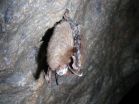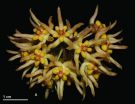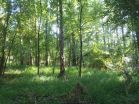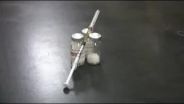(Press-News.org) COLUMBUS, Ohio--Gravity data captured by satellite has allowed researchers to take a closer look at the geology deep beneath the Tibetan Plateau.
The analysis, published in the journal Nature Scientific Reports, offers some of the clearest views ever obtained of rock moving up to 50 miles below the plateau, in the lowest layer of Earth's crust.
There, the Indian tectonic plate presses continually northward into the Eurasian tectonic plate, giving rise to the highest mountains on Earth--and deadly earthquakes, such as the one that killed more than 9,000 people in Nepal earlier this year.
The study supports what researchers have long suspected: Horizontal compression between the two continental plates is the dominant driver of geophysical processes in the region, said C.K. Shum, professor and Distinguished University Scholar in the Division of Geodetic Science, School of Earth Sciences at The Ohio State University and a co-author of the study.
"The new gravity data onboard the joint NASA-German Aerospace Center GRACE gravimeter mission and the European Space Agency's GOCE gravity gradiometer mission enabled scientists to build global gravity field models with unprecedented accuracy and resolution, which improved our understanding of the crustal structure," Shum said. "Specifically, we're now able to better quantify the thickening and buckling of the crust beneath the Tibetan Plateau."
Shum is part of an international research team led by Younghong Shin of the Korea Institute of Geosciences and Mineral Resource. With other researchers in Korea, Italy and China, they are working together to conduct geophysical interpretations of the Tibetan Plateau geodynamics using the latest combined gravity measurements by the GOCE gravity gradiometer and the GRACE gravimeter missions.
Satellites such as GRACE and GOCE measure small changes in the force of gravity around the planet. Gravity varies slightly from place to place in part because of an uneven distribution of rock in Earth's interior.
The resulting computer model offers a 3-D reconstruction of what's happening deep within the earth.
As the two continental plates press together horizontally, the crust piles up. Like traffic backing up on a congested freeway system, the rock follows whatever side roads may be available to relieve the pressure.
But unlike cars on a freeway, the rock beneath Tibet has two additional options for escape. It can push upward to form the Himalayan mountain chain, or downward to form the base of the Tibetan Plateau.
The process takes millions of years, but caught in the 3-D image of the computer model, the up-and-down and side-to-side motions create a complex interplay of wavy patterns at the boundary between the crust and the mantle, known to researchers as the Mohoroviči? discontinuity, or "Moho."
"What's particularly useful about the new gravity model is that it reveals the Moho topography is not random, but rather has a semi-regular pattern of ranges and folds, and agrees with the ongoing tectonic collision and current crustal movement measured by GPS," Shin said.
As such, the researchers hope that the model will provide new insights into the analysis of collisional boundaries around the world.
Co-author Carla Braitenberg of the University of Trieste said that the study has already helped explain one curious aspect of the region's geology: the sideways motion of the Tibetan Plateau. While India is pushing the plateau northward, GPS measurements show that portions of the crust are flowing eastward and even turning to the southeast.
"The GOCE data show that the movement recorded at the surface has a deep counterpart at the base of the crust," Braitenberg said. Connecting the rock flow below to movement above will help researchers better understand the forces at work in the region.
Those same forces led to the deadly Nepal earthquake in April 2015. But Shum said that the new model almost certainly won't help with earthquake forecasting--at least not in the near future.
"I would say that we would understand the mechanism more if we had more measurements," he said, but such capabilities "would be very far away."
Even in California--where, Shum pointed out, different tectonic processes are at work than in Tibet--researchers are unable to forecast earthquakes, despite having abundant GPS, seismic and gravity data. Even less is known about Tibet, in part because the rough terrain makes installing GPS equipment difficult.
INFORMATION:
Other co-authors on the study included Sang Mook Lee of Seoul National University; Sung-Ho Na of the University of Science and Technology in Daejeon, Korea;
Kwang Sun Choi of Pusan National University; Houtse Hsu of the Institute of Geodesy & Geophysics, Chinese Academy of Sciences; and Young-Sue Park and Mutaek Lim of the Korea Institute of Geosciences and Mineral Resource.
This research was supported by the Basic Research Project of the Korea Institute of Geoscience and Mineral Resources, funded by the Ministry of Science, ICT and Future Planning of Korea. Shum was partially supported by NASA's GRACE Science Team Program and Concept in Advanced Geodesy Program. Braitenberg was partially supported by the European Space Agency's Center for Earth Observation as part of the GOCE User ToolBox project.
Contact: C.K. Shum, +1 614 292-7118; ckshum@osu.edu
Younghong Shin, +82 10-3879-1102, yhshin@kigam.re.kr
Written by Pam Frost Gorder, (614) 292-9475; Gorder.1@osu.edu
Editor's note: Images of the gravity model are available from Pam Frost Gorder.
CHAMPAIGN, Ill. -- A microbe found in caves produces a compound that inhibits Pseudogymnoascus destructans, the fungus that causes white-nose syndrome in bats, researchers report in the journal Mycopathologia. The finding could lead to treatments that kill the fungus while minimizing disruption to cave ecosystems, the researchers say.
The yeast Candida albicans produces the compound: trans, trans-farnesol.
Candida species are already present in caves where bats hibernate and have been isolated from the bodies of healthy, hibernating bats, said University of Illinois ...
A clinical study funded by the National Institutes of Health has found that young, single black women in South Africa adhered to a daily pill regimen to prevent HIV infection--an HIV prevention strategy known as pre-exposure prophylaxis, or PrEP. This finding is the first strong indication that this population at substantial HIV risk could accept and reliably adhere to daily PrEP dosing. Men who have sex with men (MSM) and transgender women (TGW) in New York and Thailand also successfully adhered to daily dosing.
PrEP--which consists of a daily dose of two antiretrovirals, ...
Dr. Michele Rodda describes two new tropical plants species from the Hoya genus, found on the world's third largest island Borneo. The genus is one of the largest and most complex plant groups in Asia. The first to be described in the paper, H. ruthiae, is characterised with its lack of coloured milk-like sap typical for most of the Hoya species, and H. bakoensis - with its strict preference for growing epiphytically (without causing any harm to its host) and rooting inside ant nests. The study is published in the open-access journal PhytoKeys.
Collected by Ruth Kiew ...
URBANA, Ill. - Controlled burning is widely used to maintain biodiversity and enhance regeneration of important deciduous tree species such as oak and hickory, but a recent University of Illinois study found that this practice also increases the growth of an aggressive species of invasive grass.
Microstegium vimineum (also called Japanese stiltgrass or Nepalese browntop) is an abundant non-native grass in southern Illinois where the study was conducted.
"We found that fire promotes the recruitment and growth of M. vimineum, particularly under moist soil conditions," ...
Although much progress has been made in combating the global HIV/AIDS pandemic, to halt new infections and end the pandemic, a combination of non-vaccine and vaccine prevention modalities will be needed. Even with these tools, significant implementation gaps must be closed, including the targeted deployment of proven prevention methods to the populations that need them most, says Anthony S. Fauci, M.D., director of the National Institute of Allergy and Infectious Diseases at the National Institutes of Health. Dr. Fauci addressed a special session at the 8th International ...
Irvine, Calif., July 21, 2015 - The 11 percent decrease in climate change-causing carbon dioxide emissions in the U.S. between 2007 and 2013 was caused by the global financial recession - not the reduced use of coal, research from the University of California Irvine, the University of Maryland, and the International Institute for Applied Systems Analysis shows.
Experts have assumed that the drop in emissions reflected a shift toward natural gas, which produces roughly half as much carbon dioxide per unit of energy as coal and was made cheap by the hydraulic fracturing ...
Only one in three older Americans have their diabetes under control as measured by guidelines set by the American Diabetes Association, new Johns Hopkins Bloomberg School of Public Health research suggests.
Some argue that ADA guidelines may be too stringent for some older adults. But even using less stringent measures, the researchers found, there are still many older Americans whose diabetes is not well managed, a condition that can lead to multiple long-term health problems ranging from kidney disease to blindness.
In a report published in the July issue of Diabetes ...
Most of us think of infants as tiny beings whose main business is to sleep, suck and cry, without much awareness of what is happening around them. It may come as somewhat of a surprise, then, to know that newborn brains are full of feverish activity and that they are already gathering and processing important information from the world around them. At just two days after birth, babies are already able to process language using processes similar to those of adults. SISSA researchers have demonstrated that they are sensitive to the most important parts of words, the edges, ...
One of the most basic yet important surgical skills to keep a patient alive and intact may be closing wounds. It seems that doctors will now get the job done with more ease thanks to new, nontoxic surgical glue that instantly seals a bleeding wound and helps it heal without a scar or inflammation.
Inspired by nature's wonders, Korean scientists at Pohang University of Science and Technology (POSTECH) have developed a light-activated, mussel protein-based bioadhesive (LAMBA) that works on the same principles as mussels attaching to underwater surfaces and insects maintaining ...
PROVIDENCE, R.I. [Brown University] -- When the HOPE VI community revitalization project in the disadvantaged Birmingham, Ala., neighborhood of Ensley reached the phase of building walking and biking paths, green spaces, and improved lighting in 2010, two things happened, according to a new study: First, residents developed specific expectations that leisure exercise would become more plausible, and then they followed through and got out there.
Before the neighborhood's revitalization, launched in 2006 with funding from the federal program Housing Opportunities for People ...





